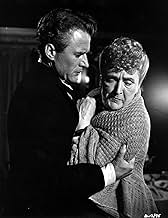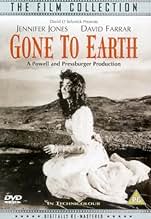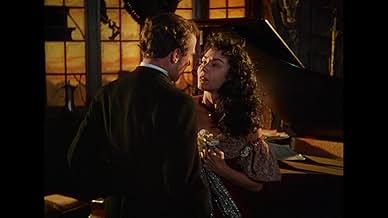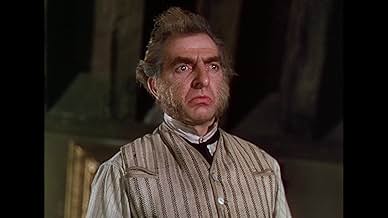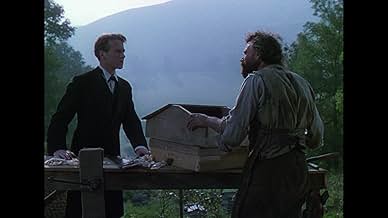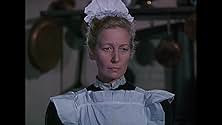IMDb-BEWERTUNG
6,9/10
1652
IHRE BEWERTUNG
Füge eine Handlung in deiner Sprache hinzuA beautiful, superstitious, animal-loving Gypsy is hotly desired by a fox-hunting squire even after she marries a clergyman.A beautiful, superstitious, animal-loving Gypsy is hotly desired by a fox-hunting squire even after she marries a clergyman.A beautiful, superstitious, animal-loving Gypsy is hotly desired by a fox-hunting squire even after she marries a clergyman.
- Regie
- Drehbuch
- Hauptbesetzung
- Auszeichnungen
- 3 Gewinne & 1 Nominierung insgesamt
Arthur Mainzer
- Chapel elder
- (as Arthur Reynolds)
Empfohlene Bewertungen
Somehow this film was made without the incessant tinkering for which David O. Selznick was notoriously famous, presumably because he had allowed his wife, Jennifer Jones, to travel to Great Britain and work her magic untrammelled by his day-to-day presence on the set and in the screening room as rushes were viewed. By all reports, however, he was so horrified by what Powell and Pressburger had wrought that what we on this side of the Atlantic were allowed to view bears only a faint resemblance to the intentions of those English artists,
It has been years since I saw, on a television broadcast, a no doubt truncated and heavily reedited version under its U.S. title, "The Wild Heart" but, as I had before, I was amazed at the "Archers" beautiful, almost florid, use of Technicolor and their apparently reckless disregard for the expectations of an audience weaned on American pablum and the more refined output of their English peers of the cinema.
Miss Jones is vibrantly beautiful and endlessly fascinating as she plays Hazel Woodus and it goes without saying that her support from a memorable cast of carefully chosen players, professional and, I would guess, amateur is of an order that one can always confidently expect from the British both on stage and on screen. It's wishful thinking, at this late date, I suppose but a VHS or DVD version, available to us here in the U.S., would be a remarkable addition to a movie-lover's library.
It has been years since I saw, on a television broadcast, a no doubt truncated and heavily reedited version under its U.S. title, "The Wild Heart" but, as I had before, I was amazed at the "Archers" beautiful, almost florid, use of Technicolor and their apparently reckless disregard for the expectations of an audience weaned on American pablum and the more refined output of their English peers of the cinema.
Miss Jones is vibrantly beautiful and endlessly fascinating as she plays Hazel Woodus and it goes without saying that her support from a memorable cast of carefully chosen players, professional and, I would guess, amateur is of an order that one can always confidently expect from the British both on stage and on screen. It's wishful thinking, at this late date, I suppose but a VHS or DVD version, available to us here in the U.S., would be a remarkable addition to a movie-lover's library.
I believe I saw this movie perhaps 50 plus years ago, as a young man. It must have been in the mid 1950s or around then. I found Jennifer Jones to be a marvelous actress in this movie and found that to be true in other movies she starred in. But I was overwhelmingly struck with the beauty of the Shrophire countryside which to some extent was almost as much of an attraction to me as Jennifer Jones. I have searched for a long time for this movie...but all I could truly remember of it , with the obvious exception of Miss Jones, was the scream or shout at the end of it ----Gone to Earth. I only know have found out what the meaning of that call was. I will be wanting to purchase this movie soon. Don Berghuis
Among the strangest, and loveliest, of the Archers films. As with so many of their films, its real subject is the profound, almost mystical, connection of people to their physical environment, most notably the British countryside. The much under-rated Jennifer Jones gives an utterly fearless performance, throwing herself into a role that sounds unplayable on paper. The Christopher Challis three-strip Technicolor photography is bold and gorgeous, underlining the central importance of the landscape. Strange in the best possible sense, in that it takes us somewhere we've never really been. Even the Bronte sisters couldn't capture rustic England as well. But they never had the benefit of Technicolor.
This was a hard film to see for a very long time, at least in any form that would do it justice. But the small snippets of it I'd caught made me steadfastly wait for the day I could view it, and having done so, I can say it's considerably better than its fairly middling reputation.
Maybe the easiest way to describe it is as Powell & Pressburger's "Wuthering Heights" - it's set in that gothic period drama genre, anyway - but at root it's a grown-up, thoughtful and adult romance-of-sorts set on windswept fairy-tale moors.
The two films it fits closest to in their body of work would be "I Know Where I'm Going" (for the elemental setting) and especially Black Narcissus, for the matchless colour photography and mood of suppressed eroticism bubbling savagely beneath the surface. You can feel the invisible forces of superstition and desire affecting events, the tiny figures swamped by a greater Nature beyond their understanding or powers.
As I've already said, this is a grown-up film, a good 15 years or more before its time in its depiction of adultery and complexity of emotion in a potboiler setting. The sexuality in it is not explicit, but it's firmly engraved in stone between the lines of the script and in small moments of quiet force - flickers of understanding, judgement or confusion passing over every face throughout, speaking volumes.
There's a lurid, hyperreal, almost cartoonishly painterly look to the colour films of the 40s and 50s, which was never seen again afterwards, and is now impossible to recreate. This one has the texture of Singin' In The Rain but is, unusually, set largely outdoors, in the real world, in wide open spaces. Because of this, the nature scenes look, gorgeously, straight out of Bambi.
Gone To Earth is not P&P's greatest film, but it's a real treasure nonetheless. A wild, dark, pagan beauty.
Maybe the easiest way to describe it is as Powell & Pressburger's "Wuthering Heights" - it's set in that gothic period drama genre, anyway - but at root it's a grown-up, thoughtful and adult romance-of-sorts set on windswept fairy-tale moors.
The two films it fits closest to in their body of work would be "I Know Where I'm Going" (for the elemental setting) and especially Black Narcissus, for the matchless colour photography and mood of suppressed eroticism bubbling savagely beneath the surface. You can feel the invisible forces of superstition and desire affecting events, the tiny figures swamped by a greater Nature beyond their understanding or powers.
As I've already said, this is a grown-up film, a good 15 years or more before its time in its depiction of adultery and complexity of emotion in a potboiler setting. The sexuality in it is not explicit, but it's firmly engraved in stone between the lines of the script and in small moments of quiet force - flickers of understanding, judgement or confusion passing over every face throughout, speaking volumes.
There's a lurid, hyperreal, almost cartoonishly painterly look to the colour films of the 40s and 50s, which was never seen again afterwards, and is now impossible to recreate. This one has the texture of Singin' In The Rain but is, unusually, set largely outdoors, in the real world, in wide open spaces. Because of this, the nature scenes look, gorgeously, straight out of Bambi.
Gone To Earth is not P&P's greatest film, but it's a real treasure nonetheless. A wild, dark, pagan beauty.
I heartily recommend this film, but as others have said before me, avoid the dreadfully hacked version- The Wild Heart. It amazes me that Selznick could ruin such a wonderful piece of cinema. For me the locations are stunningly beautiful yet bleak. Based on the Mary Webb novel the movie was filmed in Shropshire , the book , as most of Webb's were, was also set there. The windswept Stiperstones and The Devil's Chair are not make believe. They really do exist and you can easily visit these locations.I always wanted to visit Shropshire, as a child I loved the Lone Pine stories by Malcolm Saville that were set there ( I still do ). They, as Webb's stories all were set in real places. The little church ( Godshill ) in the film is still standing and you can still make out the shape of the baptism pool in the garden. It's a beautiful, atmospheric place.I have now visited these locations several times. The long chimney you see standing in several sequences can still be found in the ruins of the old Snailbeach mines. It is so wonderful to stand in these places, on these hills ( the stiperstones, the Long Mynd ) and imagine 57 years ago when all the actors and crew stood in the very same place, you can't explain how you feel, but it's something very extraordinary.The film itself is a strangely evocative piece that features eerily scored music, wild but effective performances. Cyril Cusack stands out in a restrained, dignified part as the sad parson.It is his character that I felt so sorry for.Although poor Jennifer Jones ( Hazel ) is a tormented soul that you can't help but feel attracted to.A glorious piece of cinema of the past with wonderful locations. The plot may be all too familiar but the scenery, the characters and yes, Foxy all help pass the time in a blink of an eye. Watch it a couple of times, each viewing brings out something else that you may have missed.
Wusstest du schon
- WissenswertesThe choir was the real choir from the local Methodist chapel. When he heard them singing, director Michael Powell said they were too good and he wanted them to sound "more ragged, like a choir of country folk" only to be told "But we ARE country folk, Mr. Powell."
- PatzerAs Abel and Hazel Woodus come down the hill to the chapel, the mine engine house disappears and then reappears between shots
- Zitate
Hazel Woodus: The world wasn't made in seven days only for Abel Woodus.
- Alternative VersionenThe reedited and shortened version titled "The Wild Heart" was produced after a disagreement and court case between director Michael Powell and producer David O. Selznick. Selznick's changes are mainly:- (1) Adding a prologue. (2) Adding scenes explaining things, often by putting labels or inscriptions on them. (3) Adding more close-ups of Jennifer Jones (Selznick's wife). He also deleted a few scenes that he felt weren't dramatic enough. Sadly some of these were major plot points so the story doesn't make as much sense as the original. In his autobiographies, Powell claimed that Selznick only left about 35 mins of the original film. In fact there's a lot more than that. About 2/3 of the original remains.
- VerbindungenFeatured in The Late Show: Michael Powell (1992)
Top-Auswahl
Melde dich zum Bewerten an und greife auf die Watchlist für personalisierte Empfehlungen zu.
- How long is Gone to Earth?Powered by Alexa
Details
- Erscheinungsdatum
- Herkunftsländer
- Sprache
- Auch bekannt als
- The Wild Heart
- Drehorte
- Produktionsfirmen
- Weitere beteiligte Unternehmen bei IMDbPro anzeigen
- Laufzeit1 Stunde 50 Minuten
- Seitenverhältnis
- 1.37 : 1
Zu dieser Seite beitragen
Bearbeitung vorschlagen oder fehlenden Inhalt hinzufügen

Oberste Lücke
By what name was Die schwarze Füchsin (1950) officially released in India in English?
Antwort
